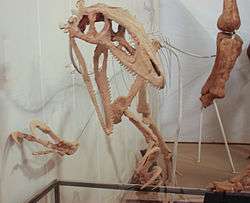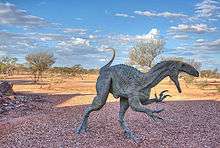Australovenator
| Australovenator Temporal range: Late Cretaceous,[1] 95 Ma | |
|---|---|
 | |
| Reconstructed skeleton, Australian Age of Dinosaurs Museum, Winton, Australia | |
| Scientific classification | |
| Kingdom: | Animalia |
| Phylum: | Chordata |
| Class: | Reptilia |
| Clade: | Dinosauria |
| Order: | Saurischia |
| Suborder: | Theropoda |
| Family: | †Neovenatoridae |
| Clade: | †Megaraptora |
| Genus: | †Australovenator Hocknull et al., 2009 |
| Species: | †A. wintonensis |
| Binomial name | |
| Australovenator wintonensis Hocknull et al., 2009 | |
Australovenator (meaning "southern hunter") is a genus of megaraptoran theropod dinosaur from Cenomanian (Late Cretaceous)-age rocks (dated to 95 million years ago[1]) of Australia. It is known from partial cranial and postcranial remains which were described in 2009 by Scott Hocknull and colleagues.
Description

According to Hocknull, it was 2 m (6.6 ft) tall at the hip and 6 m (20 ft) long, with a weight of about 500–1000 kg. Because it was a lightweight predator, he coined it as the "cheetah of its time".[2] Like other megaraptorans, Australovenator would have been a bipedal carnivore.[3]
History of discovery
Australovenator is based on a theropod specimen (AODF 604), affectionately nicknamed "Banjo" after Banjo Paterson[4]), which was found intermingled with the remains of the sauropod Diamantinasaurus matildae at the "Matilda site" (AODL 85). The only known specimen of Australovenator, which is held at the Australian Age of Dinosaurs Museum of Natural History, comprises a left dentary, teeth, partial forelimbs and hindlimbs, a partial right ilium, ribs, and gastralia. Australovenator was described in 2009 by paleontologist Scott Hocknull of the Queensland Museum, and colleagues. The type species is A. wintonensis, in reference to nearby Winton.[5]

More arm elements of the holotype were described in 2012.[6]
Rapator was described by Huene for a first metacarpal from Australia. When Australovenator was described, it was considered either an alvarezsaurid, or an intermediate theropod. Hocknull et al. (2009) identified a few distinguishing characters between the taxa, based on a poorly preserved metacarpal I from the holotype of Australovenator.[5] Agnolin et al. (2010), reclassified Rapator, instead finding it a megaraptoran, potentially sister taxon to Australovenator. They mentioned that Megaraptor, the only other taxon also preserving metacarpal I, was less similar to Rapator than Australovenator. However, there were no clear differences between the two latter taxa.[7] The metacarpals of both taxa were redescribed in White et al. (2014), who determined that they were not synonymous, adding multiple features two the potential characters identified by Hocknull et al. and Angolan et al.[1]
Classification

A phylogenetic analysis found Australovenator to be an allosauroid carnosaurian, with similarities to Fukuiraptor and carcharodontosaurids. In the initial analysis, it was shown to be the sister taxon of the Carcharodontosauridae.[5] More detailed studies found that it formed a clade with several other carcharodontosaurid-like allosaurs, the Neovenatoridae.[8] Recent phylogenetic analysis suggests Australovenator is a tyrannosauroid, like with all other megaraptorans.[9] A phylogenetic analysis in 2016 focusing on the new neovenatorid Gualicho found that Australovenator and other megaraptorids were either allosauroids or basal coelurosaurs as opposed to being tyrannosauroids.[10]
The ankles of Australovenator and Fukuiraptor are similar to the Australian talus bone known as NMVP 150070 that had previously been identified as belonging to Allosaurus sp., and this bone likely represents Australovenator or a close relative of it.[5][11] Alternatively, this bone could belong to an abelisaur.[12]
The cladogram below follows the 2010 analysis by Benson, Carrano and Brusatte.[8] Another study published later in 2010 also found the Australian theropod Rapator to be a megaraptoran extremely similar to Australovenator.[7]

| Neovenatoridae |
| |||||||||||||||||||||||||||||||||||||||
| |
The cladogram below follows the 2014 analysis by Porfiri et al. that finds megaraptorans to be tyrannosauroids.[14]
| Megaraptora |
| |||||||||||||||||||||
| |
Palaeoecology

AODL 604 was found about 60 kilometres (37 mi) northwest of Winton, near Elderslie Station. It was recovered from the lower part of the Winton Formation, dated to the late Cenomanian. AODL 604 was found in a clay layer between sandstone layers, interpreted as an oxbow lake, or billabong, deposit. Also found at the site were the type specimen of the sauropod Diamantinasaurus, bivalves, fish, turtles, crocodilians, and plant fossils. The Winton Formation had a faunal assemblage including bivalves, gastropods, insects, the lungfish Metaceratodus, turtles, the crocodilian Isisfordia, pterosaurs, and several types of dinosaurs, such as the sauropods Diamantinasaurus and Wintonotitan, and unnamed ankylosaurians and hypsilophodonts. Plants known from the formation include ferns, ginkgoes, gymnosperms, and angiosperms.[5]
References
- 1 2 3 White, M. A.; Falkingham, P. L.; Cook, A. G.; Hocknull, S. A.; Elliott, D. A. (2013). "Morphological comparisons of metacarpal I for Australovenator wintonensis and Rapator ornitholestoides: Implications for their taxonomic relationships". Alcheringa: an Australasian Journal of Palaeontology. 37: 1. doi:10.1080/03115518.2013.770221.
- ↑ Scientists discover 3 new Aussie dinosaurs. ABC News. July 3, 2009
- ↑ Holtz, Thomas R., Jr.; Molnar, Ralph E.; Currie, Philip J. (2004). Weishampel, David B.; Dodson, Peter; Osmólska Halszka (eds.), eds. The Dinosauria (2nd ed.). Berkeley: University of California Press. pp. 71–110. ISBN 0-520-24209-2.
- ↑ Australovenator on prehistoric-wildlife.com
- 1 2 3 4 5 Hocknull, Scott A.; White, Matt A.; Tischler, Travis R.; Cook, Alex G.; Calleja, Naomi D.; Sloan, Trish; Elliott, David A. (2009). Sereno, Paul, ed. "New Mid-Cretaceous (Latest Albian) Dinosaurs from Winton, Queensland, Australia". PLoS ONE. 4 (7): e6190. Bibcode:2009PLoSO...4.6190H. doi:10.1371/journal.pone.0006190. PMC 2703565
 . PMID 19584929.
. PMID 19584929. - ↑ White, M. A.; Cook, A. G.; Hocknull, S. A.; Sloan, T.; Sinapius, G. H. K.; Elliott, D. A. (2012). Dodson, Peter, ed. "New Forearm Elements Discovered of Holotype Specimen Australovenator wintonensis from Winton, Queensland, Australia". PLoS ONE. 7 (6): e39364. Bibcode:2012PLoSO...739364W. doi:10.1371/journal.pone.0039364.
- 1 2 Agnolin, Ezcurra; Pais; Salisbury (2010). "A reappraisal of the Cretaceous non-avian dinosaur faunas from Australia and New Zealand: Evidence for their Gondwanan affinities". Journal of Systematic Palaeontology. 8 (2): 257–300. doi:10.1080/14772011003594870.
- 1 2 Benson, R.B.J.; Carrano, M.T; Brusatte, S.L. (2010). "A new clade of archaic large-bodied predatory dinosaurs (Theropoda: Allosauroidea) that survived to the latest Mesozoic". Naturwissenschaften. 97 (1): 71–78. Bibcode:2010NW.....97...71B. doi:10.1007/s00114-009-0614-x. PMID 19826771.
- ↑ F. E. Novas; F. L. Agnolín; M. D. Ezcurra; J. I. Canale; J. D. Porfiri (2012). "Megaraptorans as members of an unexpected evolutionary radiation of tyrant-reptiles in Gondwana". Ameghiniana. 49 (Suppl.): R33.
- ↑ http://journals.plos.org/plosone/article?id=10.1371/journal.pone.0157793
- ↑ Molnar, Ralph E.; Flannery, Timothy F.; Rich, Thomas H.V. (1981). "An allosaurid theropod dinosaur from the Early Cretaceous of Victoria, Australia". Alcheringa. 5 (2): 141–146. doi:10.1080/03115518108565427.
- ↑ Agnolin, F. L.; Ezcurra, M. D.; Pais, D. F.; Salisbury, S. W. (2010). "A reappraisal of the Cretaceous non-avian dinosaur faunas from Australia and New Zealand: Evidence for their Gondwanan affinities". Journal of Systematic Palaeontology. 8 (2): 257–300. doi:10.1080/14772011003594870.
- ↑ Zanno, L. E.; Makovicky, P. J. (2013). "Neovenatorid theropods are apex predators in the Late Cretaceous of North America". Nature Communications. 4: 2827. Bibcode:2013NatCo...4E2827Z. doi:10.1038/ncomms3827. PMID 24264527.
- ↑ Juan D. Porfiri; Fernando E. Novas; Jorge O. Calvo; Federico L. Agnolín; Martín D. Ezcurra; Ignacio A. Cerda (2014). "Juvenile specimen of Megaraptor (Dinosauria, Theropoda) sheds light about tyrannosauroid radiation". Cretaceous Research. 51: 35–55. doi:10.1016/j.cretres.2014.04.007.
| Wikinews has related news: Three new dinosaurs discovered in Australia |